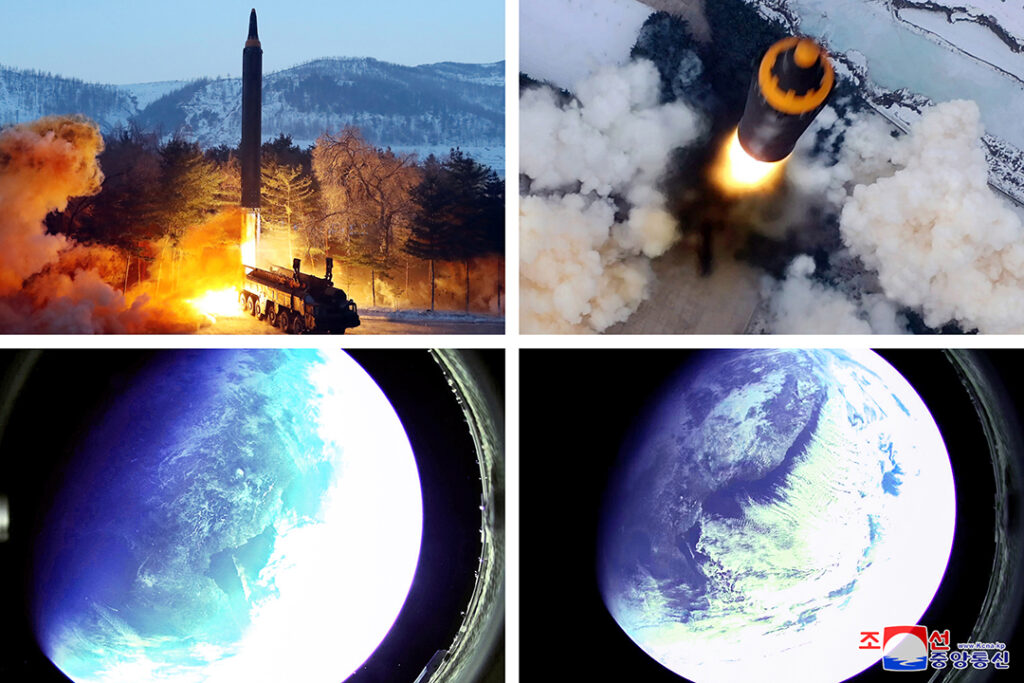REUTERS
North Korea confirmed on January 31, 2022, that it had launched a Hwasong-12 ballistic missile, sparking fears the nuclear-armed state could resume long-range testing.
The launch of the intermediate-range ballistic missile (IRBM) was first reported by South Korean and Japanese authorities January 30. It was the seventh test conducted by North Korea in January and the first time a nuclear-capable missile of that size has been launched since 2017.
The United States is concerned that North Korea’s escalating missile tests could be precursors to resumed tests of nuclear weapons and intercontinental ballistic missiles (ICBMs) and vowed an unspecified response “designed to show our commitment to our allies,” a senior U.S. official told reporters in Washington.
“It’s not just what they did yesterday, it’s the fact that this is coming on the heels of quite a significant number of tests in this month,” the official said, while urging Pyongyang to join direct talks with no preconditions.
North Korea has said it is open to diplomacy but that Washington’s overtures are undermined by its support for sanctions and joint military drills and arms buildups in South Korea and the region.
Amid a flurry of diplomacy in 2018, including summits with then-U.S. President Donald Trump, North Korean leader Kim Jong Un declared his nuclear force complete and said he would suspend nuclear testing and launches of the country’s longest-range missiles.
Kim said he was no longer bound by that moratorium after talks stalled in 2019, and North Korea suggested in January 2022 that it could restart those tests because the U.S. had shown no sign of dropping its “hostile policies.”
It is unclear if IRBMs such as the Hwasong-12 were included in Kim’s moratorium, but none had been tested since 2017. (Pictured: The Hwasong-12 missile launched by North Korea was outfitted with a camera, which took pictures from space.)
North Korea analysts said the tests appear aimed at securing global acceptance of its weapons programs, whether through concessions or simply winning tired acquiescence from a distracted world.
“The world’s distraction on other issues actually seems to be working to North Korea’s benefit right now,” said Markus Garlauskas, a senior fellow with the Atlantic Council think tank and former U.S. national intelligence officer for North Korea.
South Korean President Moon Jae-in said the recent flurry of North Korean missile tests was reminiscent of heightened tensions in 2017, when North Korea conducted multiple nuclear tests and launched its largest missiles.
South Korean Defense Minister Suh Wook visited his country’s Army Missile Command on January 31 to check its readiness in the face of the North Korean launches, the ministry said in a statement.
“North Korea’s series of missile test-fires, including intermediate-range ballistic missiles, pose a direct and serious threat to us and a grave challenge to international peace and stability,” Suh said after being briefed. “We will maintain a full military readiness posture that can respond immediately to any situation.”
Japanese Defense Minister Nobuo Kishi told reporters North Korea was escalating its provocation of the international community and said its “remarkable improvement” in missile technology “cannot be tolerated.”
State media coverage of the launch made no mention of the United States, and Kim was not reported to have attended. North Korean officials said the tests are for self-defense and not targeted at any specific country.
Kim vowed ahead of the New Year to bolster North Korea’s military capabilities in the face of international uncertainties caused by “hostile policies” by the United States and its allies.
North Korea has previously said the Hwasong-12 can carry a “large-size heavy nuclear warhead,” and analysts estimate it has a range of 4,500 kilometers (2,800 miles).
IMAGE CREDIT: REUTERS

